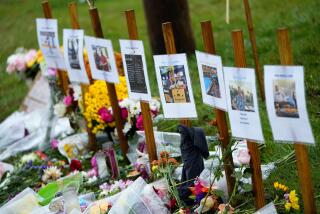High Suicide Rate Among Troops Found
WASHINGTON — Despite an increased emphasis on suicide prevention, the Army has failed to deploy sufficient numbers of mental health professionals to Iraq, provide adequate medication and train soldiers to detect signs of severe distress among their colleagues, an Army Mental Health Advisory Team has found.
The team also reported Thursday that in a study of soldiers in the Iraq conflict, 72% said there was low morale in their unit during the survey period in September. Additionally, it reported a suicide rate in 2003 of 17.3 per 100,000 troops -- 35% higher than the rate among Army troops worldwide.
The team’s findings of widespread, systemic flaws in the delivery of mental health services to troops fighting the war is highly troubling to senior Army officials, who said Thursday that they were scrambling to make things better. The team found that the Army’s system failed in training in treatment, in availability of medicines, and in communication between mental health professionals on the front lines and their superiors.
“We realized that a lot of the suicide prevention programs are based on a garrison structure,” said Col. Bruce Crow, a clinical psychologist and one of 12 senior Army officials who conducted the Iraq mental health review. “There needs to be a recognition that when you deploy a force, you are going to have to re-create that in the combat zone, because you are going to take the problem of suicides with you.”
The study, the first of its kind undertaken in a war zone, was conducted from August through October to address the mental health of U.S. soldiers involved in the Iraq occupation. It was prompted by a sharp rise in suicides during July, when five soldiers killed themselves, all with few warning signs.
Since the war in Iraq began a year ago, 24 soldiers have committed suicide. The suicide rate for Army soldiers in the Iraq campaign in 2003 was 17.3 per 100,000, compared with an overall Army rate of 12.8 for 2003 and 11.9 from 1995 through 2002.
That rate was still below the national rate of 21.5 suicides per 100,000 for men ages 20-34, the age range of most soldiers in Iraq.
The suicide rate among soldiers in the Iraq conflict compared with a rate of 15.6 per 100,000 during the Vietnam War and 3.6 per 100,000 during the brief 1991 Persian Gulf War.
Among soldiers in the Iraq campaign who took their lives, all but one did so by gunshot; the other overdosed on over-the-counter pain medication, officials said. The first suicide was last April. There has been only one suicide this year.
The survey of soldiers, conducted by Army psychiatrists and other researchers, involved only Army troops and did not cover Marines, Air Force or Navy personnel in the Iraq occupation. It targeted mainly soldiers serving on the front lines, whom the Army considers most at risk of suicide and other mental health conditions.
More than 60% of the soldiers surveyed reported low morale personally, and more than 72% reported low morale in their units.
Army officials say they believe those stark reports were associated with the time of year when the troops were surveyed -- months when temperatures regularly soared to 120 degrees; when most troops were living in tent cities without air conditioning, hot meals or showers; and when tensions were rising over how long it would be before the soldiers could return home.
Officials said they hoped the situation had improved since the survey was taken, as facilities in Iraq had improved and a troop rotation plan had been instituted. But they said that until they conducted another survey, they could not know for sure.
The psychiatrists, social workers and others on the team said they were troubled that mental health teams were often far removed from combat units. The Army ensured when it deployed to Iraq that it had one mental health professional for every 999 soldiers. But the units were widely dispersed. That often meant that a soldier seeking treatment would have had to travel long distances in dangerous conditions.
“We found that in some cases units had to put together a tactical convoy to transport soldiers to an appointment, and if a prescription was written and it was not available at that base camp, they would have to convoy to a third base camp,” said Col. Virgil Patterson, a social worker with the Army Medical Department.
The team also found that Army behavioral health units did not always have an adequate supply of antidepressant and sleeping medications. About 57% of personnel in combat-stress-control units and 67% in mental health offices attached to Army divisions in Iraq cited insufficient supplies of key medications, including antidepressants and sleep medications.
Of the soldiers who screened positive for depression, anxiety or traumatic stress, only 37% reported that they received help at any time during their deployment from a behavioral health professional, physician or chaplain, the team found.
Lt. Gen. James Peake, the Army surgeon general who oversaw the study, said the Army was sending a new consultant to Iraq in April to improve coordination, documentation and supply problems among mental health professionals in the field. The consultant, Col. Chris Piper, is a psychiatric nurse assigned to the Army Medical Department.
Army officials appeared pained by the findings, which they said were disappointing after years of attention to suicides among its troops.
“On my computer terminal is a picture of a soldier who committed suicide,” said Lt. Col Jerry Swanner, human resource officer who works for the Army’s deputy chief of staff for personnel. “I look at it every day. And in my mind is always, ‘What could I have done?’ ”
(BEGIN TEXT OF INFOBOX)
Soldier suicide
An Army study of suicides in Iraq found a rate 35% higher than that among Army troops worldwide.
Army suicide rates (Per 100,000 soldiers)
Iraq war and occupation, 2003: 17.3 Troops worldwide, 2003: 12.8 Average annual rate: 11.9
General suicide rates (Per 100,000 people)
U.S. men, ages 20-34: 21.5 U.S. women, ages 20-34: 4.1
Source: U.S. Army
More to Read
Sign up for Essential California
The most important California stories and recommendations in your inbox every morning.
You may occasionally receive promotional content from the Los Angeles Times.










